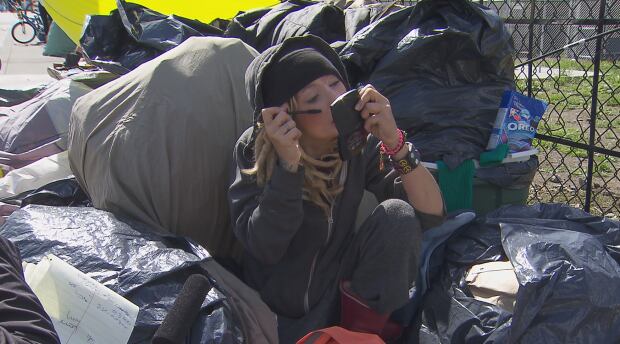The new face of fentanyl addiction: Kati’s story
When I first see her face, I think she’s been badly beaten.
Her forehead and chin are covered in blood.
Then I’m struck by how young she looks.
My next thoughts are: Who did this to her? And what the hell is she doing down here?
“Here” is The Strip — Surrey, B.C.’s notorious drug hangout. And the answers to my questions will haunt me.
I ask her if she’s all right and tell her I’m a reporter with CBC News doing a story about fentanyl creeping into street drugs.
She pushes aside one of the battered black plastic garbage bags that holds her few belongings and peers out from under her hoodie.
“Hi, I’m Kati” she says in a little-girl voice. “I only do fentanyl.”
The new face of fentanyl addiction
Kati Mather is 22.
She’s the new face of fentanyl abuse, one of many people turning to the super-potent synthetic opioid after first taking it by accident — or, at least, without knowing what it truly is.
She’s hooked on the high it delivers even though it has almost killed her.
Kati tells me she’s overdosed 11 times, most recently just a few days ago.
She says she’s been saved by friends or paramedics administering naloxone, a powerful opioid antidote now being carried by first responders and many residents of The Strip.
I ask her if she’ll give me a TV interview and tell her story.
“Oh my God, I look terrible!” she says. “Let me put on some makeup.”

Kati Mather wanted to put on makeup to cover the damage fentanyl has done before she would do an on-camera interview. (Cliff Shim/CBC )
She dabs at the blood on her face, revealing raw patches of flesh underneath. She, like many addicts, has been clawing at her own skin — a side-effect of drug withdrawal that makes users feel as though their skin is crawling.
No one has beaten her. Her wounds have been ripped open by her own fingernails.
She expertly hides her red, seeping sores with flesh-coloured cover-up.
Kati then pulls together some of her lumpy plastic bags to form a makeshift chair on the sidewalk. She fusses, sits, then seems satisfied.
“Perfect,” she says.
I don’t tell her how sad that statement makes me feel.
‘I’ve always been addicted to something’
I ask her how she got here and how she started taking fentanyl.
Kati talks quickly but thoughtfully, her matter-of-fact delivery in stark contrast to the extraordinary things she reveals.
“Actually, it’s funny,” she says, then stops and reconsiders. “Well, it’s not funny, it’s terrible. I’ve been using fentanyl before I ever tried heroin.”
She forges ahead before I can even digest that statement.
“I have a really addictive personality. I’ve always been addicted to something, whether it was shopping or Facebook or whatever. And I did oxy [oxycontin]. I got addicted right away. I then found a regular dealer and started picking up all the time.”
As she talks, the blood starts to seep through her makeup. I try not to stare at the red stain growing on her chin.

The Strip, a notorious drug hangout in Surrey, B.C., where Kati has been living. She says she has overdosed at least 11 times. (Cliff Shim/CBC )
“I remember the day that fentanyl came out… My dealer said, ‘You know, I’ve got these new pills, they’re fake oxys.’ He didn’t tell me they were fentanyl, because nobody knew what fentanyl was yet. He just said they’re a hundred times stronger and they’re only five dollars more. And I was just like, ‘OK!’ because, you know, I was getting a pretty high tolerance at this point.”
Kati barely takes a breath. She’s deep into reminiscing about how her love-hate relationship with fentanyl began.
“I could buy one and I’d crush them up and snort them. Put them into four lines, and two lines would last me a full day. That’s how strong it was,” she says. “And if I did a whole pill, I’d OD.”
At the mention of overdose, Kati suddenly grows more serious.
“Every time I do dope, I know I’m taking a risk. I know I might die. But it doesn’t matter how many times I’ve OD’d, I still use the next day because the withdrawals are so bad.”
‘You might remember me…’
Kati has another surprise for me.
“I’ve been in the news before,” she says. “You might remember me.”
It turns out, I do.
Kati and her twin sister Jessi were attacked by a Rottweiler-husky cross in December of last year. Kati was critically injured and required emergency surgery. It made the headlines.
- B.C. dog attack victim Kati Mather recovering after surgery, says father
- Yogi, Rottweiler-cross, to be euthanized following attack in B.C. park
Efforts on social media to raise money to help pay their medical bills fizzled when it was revealed the pair had an Instagram account called Twins That Toke, and allegations were floated that they might have fed the dog some drugs.
Kati now looks nothing like the happy young woman in her Facebook pictures that were used to tell her story just nine months ago.
It’s been downhill since then. She blames the pain from the dog attack for pushing her deeper into addiction. She ended up on The Strip in early summer.
Kati has lost everything thanks to her addiction to fentanyl.
‘At first it was for fun…a party drug’
I ask her how she feels now, looking back.
“Well, at first it was fun, right? It was just for fun,” she says, remembering her introduction to fentanyl.
“It was a party drug … and there’s been some things that I’ve gone through and it helped with a lot of pain. And especially after that dog attack, I just couldn’t stop.”

Kati and her twin sister Jessi were attacked by a Rottweiler-husky cross they were walking in Dec. 2015. Kati was critically injured and required emergency surgery. (Facebook)
Kati says she has tried quitting fentanyl a few times but couldn’t hang on long enough to get into a treatment bed. A shortage in the province means long waits.
“They expect you to stay clean on your own for three to eight months while you’re on a waiting list to get into a treatment centre,” she says. “How is that possible when you’re an addict? You call every day. I did it for three months — then I relapsed.”
- Fentanyl deaths are a Canada-wide ‘disaster’
- What you need to know about fentanyl, which can kill you in one dose
Her indignation grows. Her voice rises.
“Getting clean isn’t the hard part,” she says. “Getting clean is soooo easy. It’s staying clean that’s hard.”
I ask her if she worries about herself — and her future.
“I just like to take things one day at a time, right? Just go with it. And hopefully, hope for the best.”
For now, the best Kati can hope for is to wake up after her next fix of fentanyl.